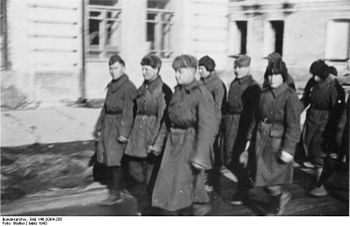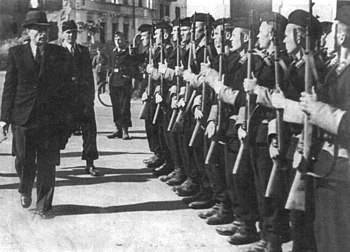Belarusian auxiliary police



The Belarusian auxiliary police ( Belarusian Беларуская дапаможная паліцыя ) was an auxiliary police of the German order police in the Reichskommissariat Ostland .
In October 1941 the number of auxiliary police officers was around 250. By 1944 it had risen to 2,263 men.
history
In contrast to the occupied countries in Western Europe, there was no longer a functioning police force in Belarus that the German occupying power could fall back on for its own purposes. The Soviet police officers were evacuated and viewed as "thugs of Bolshevism". For this reason, the Germans used people who had no professional experience as police officers when setting up the auxiliary police. The auxiliary policemen were given white armbands with the inscription “auxiliary police” and were equipped with clubs. Some of the militias were armed relatively quickly, but it also took several weeks for at least some of the auxiliary police officers to receive rifles or pistols, mostly of Soviet origin, in each town. Until the end of August 1941, the auxiliary police officers were subordinate to the local and field commandants.
When it became clear from 1943 that the National Socialist German Reich would lose the war, many local auxiliary police deserted. The Germans killed the relatives of the former policemen in order to prevent other auxiliary police from deserting. Many of the other policemen knew they would be punished by the Soviet Union for their collaboration . Auxiliary police, who made it to areas outside the control of the Soviet Union, moved to western states like the USA after the war. Those who stayed behind or were caught by the Red Army and other government agencies were sentenced to death and executed.
tasks
The tasks of the auxiliary police included maintaining public order, preventing and prosecuting crimes, guarding important buildings and thwarting all actions directed against the Germans. This also included the disenfranchisement, persecution and, ultimately, the murder of local Jews. Furthermore, the auxiliary police were involved in collecting the taxes set by the Germans and were responsible for enforcing the duty to work.
In addition, the auxiliary policemen were involved in the fight against partisans under the name “Schutzmannschaften” . The actions of the protection teams, which mostly took place under the leadership of the German occupiers, took place with great brutality. Since the partisans mingled with the population without being recognized, their identification turned out to be extremely difficult, which led to the fact that the operations not infrequently resulted in massacres of all or at least large parts of the village population. This was also due to the fact that in addition to partisans, their sympathizers and supporters were also destroyed. For example, on January 13, 1943, sixty residents in the village of Ljadki, who allegedly had links to the partisans, were murdered by five German gendarmes and a hundred policemen. women and children were among the victims. In March 1943, 91 people were killed and two hundred houses set on fire in two other villages. The protection teams were also involved in the Poland campaign. The auxiliary police arrested numerous people of Polish nationality, some of whom were shot in custody.
crime
In March 1942, the Koldyczewo camp was established, which was mainly led by the police . The prisoners were initially Soviet "activists" such as members of the Komsomol , the CPSU , deputies of the local Soviets and former Soviet employees. Polish resistance fighters, partisans and Jews were later sent to the camp. The prisoners had to perform forced labor and were cruelly punished for the slightest misconduct or for no reason whatsoever. In a special torture chamber, the inmates were tortured with electric shocks. The prisoners were also murdered, which often happened on the orders of the higher-level SD agencies. In some cases, the policemen killed the prisoners out of sheer sadism even without instructions . In an attempted mass escape on April 1, 1944, the auxiliary police were able to arrest 17 women, cut off their breasts and crucified them on the floor.
On October 20, 1941, units of the Belarusian auxiliary police together with SS officers and soldiers, some of whom came from Latvia, murdered 7,000 of the 8,000 Jews living in the city in Baryssau on behalf of Mayor Stanislau Stankewitsch . In the mass murder, the still living victims had to place the ones shot in front of them as space-saving as possible and cover them with a thin layer of sand before they were shot themselves. In addition, the troops were instructed to shoot through with one shot by two people in order to save ammunition. The Red Cross could not find any wounds on the bodies of the young children during the autopsy of the victims, suggesting that they were buried alive.
In several villages, young women and girls were mass raped by German and Ukrainian soldiers, but also by local protection teams.
literature
- Alexander Brakel: Under the Red Star and Swastika. Baranowicze 1939 to 1944. Western Belarus under Soviet and German occupation . (= Age of World Wars. Volume 5). Ferdinand Schöningh Verlag, Paderborn et al. 2009, ISBN 978-3-506-76784-4 , pp. 193-206.
Individual evidence
- ↑ Alexander Brakel: Under Red Star and Swastika. Baranowicze 1939 to 1944. Western Belarus under Soviet and German occupation . (= Age of World Wars. Volume 5). Ferdinand Schöningh Verlag, Paderborn et al. 2009, ISBN 978-3-506-76784-4 , pp. 194/195.
- ↑ Alexander Brakel: Under Red Star and Swastika. Baranowicze 1939 to 1944. Western Belarus under Soviet and German occupation . (= Age of World Wars. Volume 5). Ferdinand Schöningh Verlag, Paderborn et al. 2009, ISBN 978-3-506-76784-4 , p. 193.
- ↑ Alexander Brakel: Under Red Star and Swastika. Baranowicze 1939 to 1944. Western Belarus under Soviet and German occupation . (= Age of World Wars. Volume 5). Ferdinand Schöningh Verlag, Paderborn et al. 2009, ISBN 978-3-506-76784-4 , p. 205.
- ↑ Alexander Brakel: Under Red Star and Swastika. Baranowicze 1939 to 1944. Western Belarus under Soviet and German occupation . (= Age of World Wars. Volume 5). Ferdinand Schöningh Verlag, Paderborn et al. 2009, ISBN 978-3-506-76784-4 , p. 206.
- ↑ Alexander Brakel: Under Red Star and Swastika. Baranowicze 1939 to 1944. Western Belarus under Soviet and German occupation . (= Age of World Wars. Volume 5). Ferdinand Schöningh Verlag, Paderborn et al. 2009, ISBN 978-3-506-76784-4 , p. 194.
- ↑ Alexander Brakel: Under Red Star and Swastika. Baranowicze 1939 to 1944. Western Belarus under Soviet and German occupation . (= Age of World Wars. Volume 5). Ferdinand Schöningh Verlag, Paderborn et al. 2009, ISBN 978-3-506-76784-4 , p. 198.
- ↑ Alexander Brakel: Under Red Star and Swastika. Baranowicze 1939 to 1944. Western Belarus under Soviet and German occupation . (= Age of World Wars. Volume 5). Ferdinand Schöningh Verlag, Paderborn et al. 2009, ISBN 978-3-506-76784-4 , p. 194.
- ↑ Alexander Brakel: Under Red Star and Swastika. Baranowicze 1939 to 1944. Western Belarus under Soviet and German occupation . (= Age of World Wars. Volume 5). Ferdinand Schöningh Verlag, Paderborn et al. 2009, ISBN 978-3-506-76784-4 , p. 195.
- ↑ Alexander Brakel: Under Red Star and Swastika. Baranowicze 1939 to 1944. Western Belarus under Soviet and German occupation . (= Age of World Wars. Volume 5). Ferdinand Schöningh Verlag, Paderborn et al. 2009, ISBN 978-3-506-76784-4 , p. 196.
- ↑ Alexander Brakel: Under Red Star and Swastika. Baranowicze 1939 to 1944. Western Belarus under Soviet and German occupation . (= Age of World Wars. Volume 5). Ferdinand Schöningh Verlag, Paderborn et al. 2009, ISBN 978-3-506-76784-4 , p. 198.
- ↑ Mark Alexander: Nazi Collaborators, American Intelligence, and the Cold War. The Case of the Byelorussian Central Council. University of Vermont Graduate College Dissertations and Theses, No. 424, 2015, p. 40.
- ↑ Borisov , in: Guy Miron (Ed.): The Yad Vashem encyclopedia of the ghettos during the Holocaust . Volume 1. Jerusalem: Yad Vashem, 2009, p. 68.
- ^ Morris Riley: Philby. The hidden years. Janus Publishing Company, London 1999, p. 37.
- ↑ John Loftus: America's Nazi Secret. TrineDay LCC 2010, p. 58.
- ↑ Alexander Brakel: Under Red Star and Swastika. Baranowicze 1939 to 1944. Western Belarus under Soviet and German occupation . (= Age of World Wars. Volume 5). Ferdinand Schöningh Verlag, Paderborn et al. 2009, ISBN 978-3-506-76784-4 , pp. 193-201.
